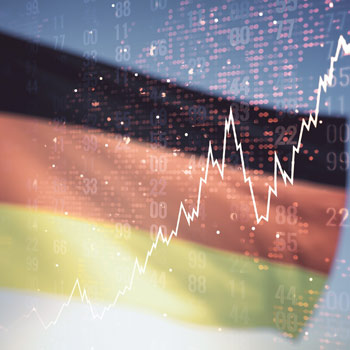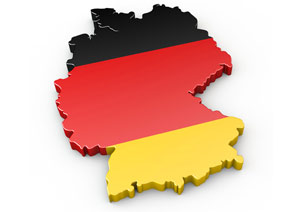
What do I need to know before trading the Dax 40 German stock index?
First of all, of course, we'd like you to find out a little more about this stock market index and how it works in general. An excellent knowledge of the DAX 40 is of course essential if you are to understand how it can move over the longer or shorter term.
The DAX is a stock market index created directly by the Frankfurt Stock Exchange. This is not only Germany's largest stock exchange, but also the tenth largest in the world. The index was created on 30 December 1987, with a base price of 1,000 points. Another special feature of the DAX 40 index is that it is the oldest European stock market index on the world market.
In fact, the DAX 40 stock market index was created in the 1980s as a replacement for an older index. This index was known as the Börsen Zeitung and had been created by a German financial daily in 1959.
Over time, Deutsche Böerse, the DAX operator, added other indices to the major DAX 40 index. These include the MDAX, an index listing the 50 largest German companies after the DAX 30, and the TecDAX, an index representing the 30 largest German companies specialising in the technology sector, similar to the American NASDAQ.
A few facts about the German market are also important to know, not least that Germany is not only the leading economic power in Europe, but also the fifth largest economy in the world. This is made possible by the companies that make up the DAX 40, which together account for more than 75% of the total market capitalisation of the Frankfurt stock exchange. So it's easy to see why the markets are so interested in this index.
Trade the DAX 40!{etoroCFDrisk}% of retail CFD accounts lose money - etoro.com
How do I trade the DAX 40?
Trading on the DAX 40 stock index allows investors to participate in the performance of the 40 largest companies listed on the Frankfurt stock exchange in Germany. Here's an overview of the different ways of trading the DAX 40:
Investing in the DAX 40 with ETFs
ETFs (exchange-traded funds) offer a simple and diversified way of investing in the DAX 40. For example, the iShares Core DAX UCITS ETF (DE) allows investors to buy a share of a portfolio that reflects the composition of the DAX 40 index.
By holding this ETF, investors benefit from the overall performance of the index with a single transaction. This offers instant diversification, as the ETF holds stocks from all the companies in the index, spreading risk across the entire German market.
Trading the DAX 40 with CFDs
CFDs (Contracts for Difference) are derivative financial instruments that allow traders to speculate on changes in the price of the DAX 40 index without having to physically own the underlying assets.
For example, a trader can open a long position in a DAX 40 CFD if he thinks the index will rise, or a short position if he expects it to fall. Suppose a trader opens a long position in a DAX 40 CFD when the index is at 12,000 points.
If the index rises to 12,200 points, the trader makes a profit corresponding to the difference in points multiplied by the amount of the investment.
However, it is important to note that CFD trading involves risks, not least because of the leverage effect, which amplifies both gains and losses. It is therefore essential for traders to manage their risk appropriately and to fully understand how CFDs work before engaging in this type of trading.
Trade the DAX 40!{etoroCFDrisk}% of retail CFD accounts lose money - etoro.com
How do I analyse the DAX 40 index price before trading it?
Before trading the DAX 40 index, it is essential to carry out an in-depth analysis combining both technical and fundamental analysis. Here's how to go about it:
Technical analysis
- Using Charts: Traders often use charts to identify trends and price patterns. Japanese candlestick or bar charts are commonly used, and the most popular time periods range from intraday to weekly charts.
- Technical Indicators: Technical indicators such as moving averages, Bollinger Bands, RSI (Relative Strength Index) and MACD (Moving Average Convergence Divergence) can provide indications of the strength and direction of a trend, as well as overbought or oversold levels in the market.
- Support and Resistance Levels: Identifying key support and resistance levels can help traders make informed decisions about entry and exit points. These levels are often based on historical price levels where the index has bounced or consolidated previously.
Fundamental Analysis
- Economic Assessment: Traders should closely monitor key economic indicators that can influence the DAX 40 index, such as interest rates, inflation, unemployment rates, and economic growth data in Germany and the European Union.
- Market News and Events: Announcements concerning the companies making up the DAX 40 index, as well as political and geopolitical developments, can have a significant impact on its price. It is therefore crucial to keep abreast of relevant news.
- Company analysis: Examining the financial reports of the individual companies making up the DAX 40 index can provide information on their financial health and growth prospects, which can influence the overall performance of the index.
By combining these two analytical approaches, traders can obtain a more complete overview of the market and make more informed trading decisions. It is also advisable to use several sources of information and consult analyses from different perspectives to obtain a more nuanced picture of the market.
What is the composition of the DAX 40 stock index?
As its name suggests and as we mentioned earlier, the DAX 40 stock market index is made up of the 40 biggest companies on the German market in terms of total market capitalisation. It includes companies from a wide range of sectors. Contrary to what you might think, although the German economy is often associated with the automotive industry, companies in the chemicals sector, including the Bayer group and the BASF group, top the index. Of course, carmakers such as Daimler, BMW and of course Volkswagen are also present, with a significant share of the index weighting.
It is also worth noting here that while the volatility of the DAX 40 stock market index is particularly high, it is made up of companies with strong resilience. Of the 40 companies that make up the index, 17 were already present when it was created in 1988.
Here is the list of companies making up the DAX 40 index at the start of 2024, along with their respective sectors of activity:
- ADIDAS (ADS.DE) - Sector: Consumer Services
- ALLIANZ (ALV.DE) - Sector: Financials
- BASF (BAS.DE) - Sector: Basic Materials
- BAYER (BAYN.DE) - Sector : Healthcare
- BEIERSDORF (BEI.DE) - Sector : Consumer Goods
- BMW (BMW.DE) - Sector : Consumer Goods
- BRENNTAG (BNR.DE) - Sector : Basic Materials
- COMMERZBANK (CBK.DE) - Sector : Financials
- CONTINENTAL (CON.DE) - Sector : Consumer Goods
- COVESTRO (1COV.DE) - Sector : Industries
- DAIMLER TRUCK (DTG.DE) - Sector : Consumer goods
- DEUTSCHE BANK (DBK.DE) - Sector : Financials
- DEUTSCHE BOERSE (DB1.DE) - Sector : Financials
- DEUTSCHE POST (DHL.DE) - Sector: Utilities
- DEUTSCHE TELEKOM (DTE.DE) - Sector: Telecommunications
- E.ON (EOAN.DE) - Sector : Utilities
- FRESENIUS (FRE.DE) - Sector : Healthcare
- HANNOVER RUECK (HNR1.DE) - Sector : Financial Companies
- HEIDELBERGCEMENT AG O.N. (HEI.DE) - Sector : Industry
- HENKEL PFD (HEN3.DE) - Sector: Consumer Goods
- INFINEON TECHNOLO (IFX.DE) - Sector : Technologies
- MERCEDES-BENZ GROUP AG (MBG.DE) - Industry: Consumer Goods
- MTU AERO ENGINE (MTX.DE) - Sector : Industries
- MUENCHENER RUECKV (MUV2.DE) - Sector : Financials
- PORSCHE AG (P911.DE) - Sector : Consumer goods
- PORSCHE AUTO (PAH3.DE) - Sector : Consumer goods
- QIAGEN (QIA.DE) - Sector : Basic Materials
- RHEINMETALL (RHM.DE) - Sector : Technologies
- RWE (RWE.DE) - Sector : Utilities
- SAP AG O.N. (SAP.DE) - Industry: Technology
- SARTORIUS AKTIENGESELLSCHAFT (SRT3.DE) - Sector : Healthcare
- SIEMENS (SIE.DE) - Sector : Industries
- SIEMENS ENERGY (ENR.DE) - Sector : Utilities
- SIEMENS HEALTH (SHL.DE) - Sector : Healthcare
- SYMRISE (SY1.DE) - Sector : Consumer goods
- VOLKSWAGEN VZ (VOW3.DE) - Sector : Consumer goods
- VONOVIA (VNA.DE) - Sector : Financials
- ZALANDO (ZAL.DE) - Sector: Consumer Goods
Of course, the composition of the DAX 40 index changes over time, with some companies leaving the index and being replaced by others, depending on their market capitalisation.
Trade the DAX 40!{etoroCFDrisk}% of retail CFD accounts lose money - etoro.com
What method is used to calculate the DAX 40 share price?
To take you a step further, we'd like to explain how the DAX 40 index price is calculated.
First of all, we'd like to remind you of the criteria required for a company to be included in this index. To be included in the DAX 40, a company must be listed on the Prime Standard segment of the Frankfurt stock exchange. It must also have at least 10% of its stocks listed on the stock exchange and held by the State. Finally, the company must have been listed on the stock exchange for at least 30 days since its initial listing.
For a company to drop out of the DAX 40 index, it must fall to 45th place or below in terms of market capitalisation. Of course, a company that becomes insolvent will also be removed from the index. It should also be remembered that every quarter, the German Stock Exchange Committee meets to decide on the inclusion or exclusion of companies from the DAX index on the basis of their market capitalisation and the volume of their order book.
As for the calculation of the DAX 40 index itself, it depends on the market capitalisation of companies and uses a methodology based on the free-float principle, which takes account only of stocks that are actually available. It should also be noted that none of the companies making up this index can exceed a weighting of 10%.
What you need to know before analysing the DAX 40?
Before you begin analysing the DAX 40 share price, you should also be aware of some of its special features and characteristics. It is not possible to buy the DAX 40 in the same way as a stock on the stock exchange, and speculation in this stock is therefore based on derivatives.
It is also important to note that the DAX 40 index is highly volatile, even more so than some other international stock indices. This represents a risk for investors that it is important to bear in mind. Historically, the DAX 40, formerly known as the DAX 30, grew significantly during its first few years of trading, exceeding 2,000 points in 1993, then 5,000 points in 1998 and finally 7,500 points in 2000. Between 2003 and 2007, a bull market saw the index reach a new high of 8,105.69 points.
Also from a historical perspective, the DAX 30 was particularly hard hit by the speculative bubble in the early 2000s, with a bear market lasting 3 years that saw the index fall to 2,500 points before gradually recovering.
The strong growth of some of the German companies that make up this index are responsible for this very high volatility, and so need to be monitored very closely.


